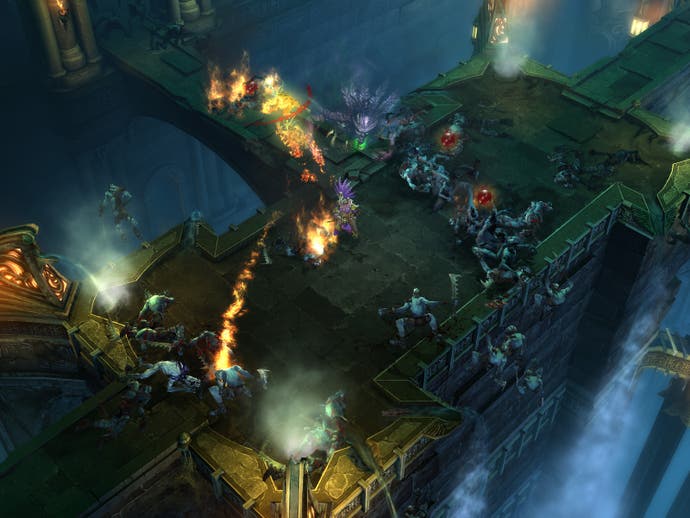Diablo III
The devil makes work for clicking hands to do.
While most casting characters are based around elemental powers, the Wizard owes its dues to cosmology. Energy and time seem to be the weapons of choice, and this reflects a concerted effort on the part of Wilson and his team to create something different.
"When we dived into the source material that inspired [the Wizard], which was really old-school, pen-and-paper role-playing-game type magic users, those magic users were not the traditional elementalists that the mage and sorcerer turned into," Wilson told us. "They really did all kinds of crazy things, like disintegrating, controlling time and conjuring things out of nothing... That's what really inspired it."
Levelling up these characters has been given an extra dash of visceral thrill - there is an explosion of light (nothing new) but this is followed by a shockwave that kills or seriously injures nearby enemies. The experience of climbing a level with an explosion that takes out a group of mobs is a brilliantly inspired layer of polish that only Blizzard could think of - it's not necessary, it's just amazingly fun.
However, not all is as it should be - yet. The Barbarian is currently lacking in any really interesting skills that are playable, and the Witch Doctor has the least customisable appearance. All the classes also seemed to be too powerful; after making my way through the dungeon without dying (partly thanks to the red health orbs that mobs now drop), I had reached a high enough level to face the Skeleton King without much of a challenge. I toyed with him for some time, trying to raise character's level one more notch before finishing him off, but in the end I put the Thriller reject out of his misery and finished the dungeon.
Controls are important to Blizzard, whose mantra is "easy to learn, hard to master"; and they're also important to Jay Wilson. "I love interface and controls, they're some of my favourite pats of the game, and I'm a big believer that good interface is less interface," he says.

The simple one-click nature of Diablo remains intact: left click to attack, right click to attack, click to pick up items, click to walk, etc. Players are faced with a choice of three skills to equip: one for the left click, one for the right and another in reserve that can be used to substitute the right mouse button's spell by pressing tab. To change to any other skill you right click on the abilities' icon attached to either mouse button and select a replacement, while certain buffs are automatically assigned to the number bar.
Wilson explained the interface and control design, saying: "By forcing yourself to be simple, it really makes your depth have to come from somewhere else, which some people find really interesting."
Diablo III is already shaping up to be everything you want the title to be; it's different enough to show a real improvement on the originals but respectful enough to play off their strengths. As with most things Blizzard develops, the innovation comes in new combinations of previously tried and tested ideas, polished to a high degree. There are some areas that need balancing, but this is early days yet, and if the title's development continues to progress in the right direction then Diablo III looks set to join its predecessors as a gaming icon.